Interviews
Interview and Studio Visit: Tom Anholt
by Artland Editors
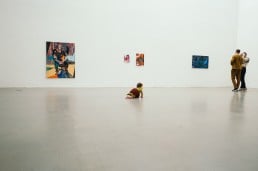
On a recent visit to Berlin, Artland sat down with Tom Anholt in his studio to ask him a few questions about his paintings and working practice. Currently his work can be seen at renowned gallery Eigen + Art in Leipzig, in an exhibition entitled Vom Leben (From Life).
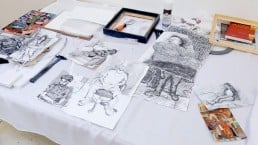
This body of work, for the exhibition Vom Leben (From Life) at Eigen + Art in Leipzig, seems somewhat more personal than other groups of works you have made. It contains a lot of imagery of friends and family right?
Exactly. These works began after the birth of my daughter. I started by making drawings of her and these led to paintings. Originally they were not intended to be shown, but when friends came to visit the studio I asked them to sit for me and the series evolved into a significant body of work.
How much are these paintings about your personal present and the people around you? Do you consider them, and your life with them, as subjects of the paintings, or are they vehicles for something else in the work?
These paintings are about my life in the past year and some of the people who are important to me. Having a baby has taught me to look at my immediate surroundings with wonder again.
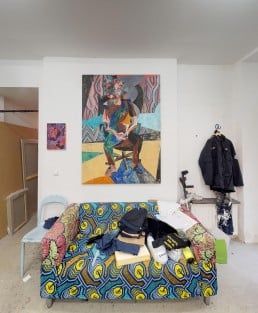
Your paintings are always rich in narrative. Are there universal themes that are common to all your bodies of works, or do they function as discrete groups, each with particular stories to tell?
I tend to have quite a simple starting point to a series of work. Sometimes that’ll be one painting that has excited me and starts off the process. In my mind I like to simplify this; The portrait series, the tree series, the water series. This allows me to work on a few shows at once. As Picasso said, ‘With constraint comes creation’.
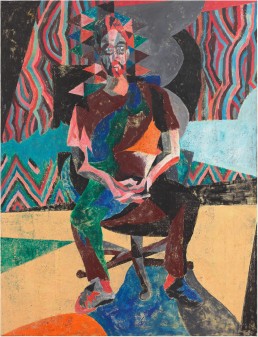
There is a wide array of visual reference in your paintings. You have spoken of your discovery of Persian miniatures, but other affinities abound, with tapestry and textile, the flattened perspective and pictorial quality of early Renaissance paintings, and even illustrations of myths, legends and fairytales one would find in children’ books coming to mind. Do you avidly look at a very wide range of visual cultures and productions, and what things can you say have particularly inspired you and why?
I am constantly looking to be influenced. I want to walk around like a sponge. I often say painting is like chasing a ball that is made up of all your influences, your desires, your fears. Things are constantly being added and taken away. I would never specifically look at a reference while working, but its all in there, jumbled around. Anything that I see and love will creep its way in sooner or later. I find the best way is to allow that process to happen in its own time.

Speaking of visual influences, you live and work in Berlin. You have commented briefly that this influences your practice subliminally in lots of ways that might be hard to quantify. Do you feel that your work has a strong affinity for German painting? Some of your practice bears the visual influence of artists like Klee, Feininger, plus wider similarities with many artists one finds in die Brücke, Der Blaue Reiter and the bauhaus. It is of course a seminal era at the beginning of modernism. Is this something you have become much more conscious of being in Berlin?
Yes. At around 14 I saw a Max Beckamnn show at Tate Britain which changed everything for me. At the time I wanted to play football for Arsenal but after that show I wanted to be a painter. Since being in Berlin I can say that German Expressionism has definitely reemerged as a massive inspiration; I put it to the side a little during art school while I tried to learn about contemporary art.
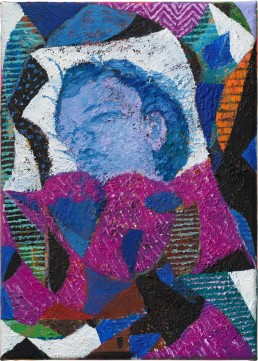
I’d like to ask a few technical questions about your work. Has it now become a habit to work up a composition and it’s related colour(s) with preparatory drawings?
It tends to change with every series. These portraits started with black and white drawings. Some series start with watercolour studies. Some start without any studies. If I feel too confident about how to make my own paintings I want to change the process because it usually mean I’m done with a particular way of working.
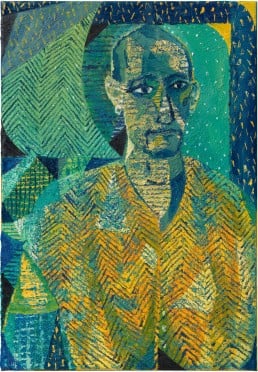
You have said that you work on one painting at a time, rather than a group. Is it easy for you to know when a work is finished?
I don’t know why I do that. I think I just find it hard to think of more than one thing at once. I would love to have a whole series bubbling away but I always get sucked into one and can’t stop.
Your works appear quite dense in many ways with a built up surface. Heavy colours with tessellated patterns are butted up against the figural elements and each other. It’s interesting that they can simultaneously resemble tapestry, woodblocks, vellum manuscript even. Can you describe your painting process a bit? Is it purely painting, or does collage, grattage, and other ways of making play a part? I’m interested in the techniques and methods that give your work these unique physical properties.
Again this changes from series to series. A year ago the paintings were built up with collaged elements of old paintings and scraps of canvas, but I felt this became a trick and I knew too well how to make it work, so I dropped it. The most exciting surfaces always tend to occur from a genuine fight with the painting; a destruction and rebuilding. All I want is that the paintings are not simply interesting images, but that they reward being looked at in life, and describe the process of their own making.
Thanks for letting us visit your studio, Tom. It’s been a pleasure to learn more about your work. We wish you every success with your new exhibition and all future projects.
Great to have you here and to be part of this innovative project. Thank you.